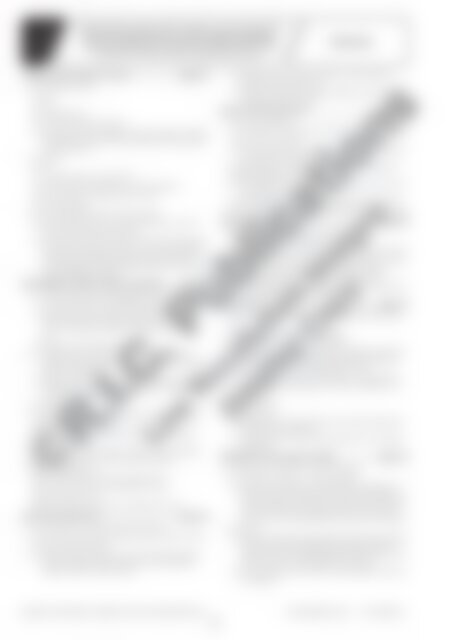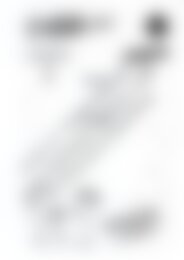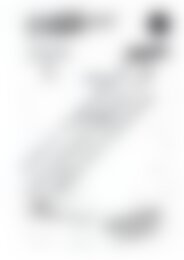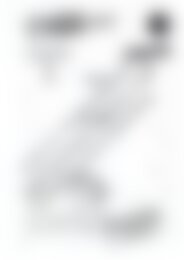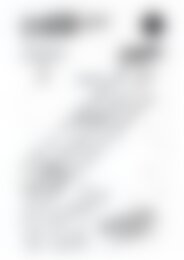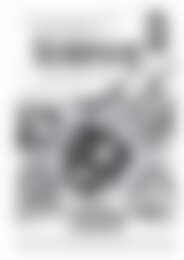20895 ACE Language (Yr 6) Structures and Language Features
Create successful ePaper yourself
Turn your PDF publications into a flip-book with our unique Google optimized e-Paper software.
Text structure<br />
<strong>and</strong> organisation<br />
Underst<strong>and</strong> how authors often innovate on text structures <strong>and</strong><br />
play with language features to achieve particular aesthetic,<br />
humorous <strong>and</strong> persuasive purposes <strong>and</strong> effects (<strong>ACE</strong>LA1518)<br />
© Australian Curriculum: Assessment <strong>and</strong> Reporting Authority 2012<br />
Answers<br />
Young cyclist remains in coma ........................page 12<br />
1. (a) a newspaper reporter<br />
(b) third<br />
(c) facts<br />
(d) the general public<br />
(e) It was written to give information.<br />
(f) Answers may include: a headline so readers will read on to fi nd out<br />
what happened, a photo of the boy, comments by the boy’s father<br />
<strong>and</strong> the truck driver<br />
2. (a) The boy<br />
(b) fi rst<br />
(c) It expresses opinions as well as facts.<br />
(d) It was written to persuade others to wear their helmets.<br />
(e) parents, teachers <strong>and</strong> students from the school<br />
(f) wear bike helmets<br />
3 (a) It says the helmet was found on the h<strong>and</strong>lebars.<br />
(b) The boy tells them he wasn’t wearing his helmet <strong>and</strong> it was his<br />
fault, <strong>and</strong> that they should wear theirs.<br />
(c) Answers will vary but may include information about the purposes<br />
for which the two texts were written; i. e. one to give information<br />
to the public <strong>and</strong> the other to persuade students <strong>and</strong> others to<br />
wear bike helmets, the intended audience, the media it was written<br />
for <strong>and</strong> the people who wrote it.<br />
Glen Wallace Primary School newsletter .......page 13<br />
1. (a) The text tells the story of what happened, then tells people what<br />
the writer thinks they should think about <strong>and</strong> do.<br />
(b) Answers will vary but may include that the boy did it for a more<br />
dramatic effect, that he wanted his readers to know the whole<br />
story, or he thought it would be more persuasive if he did it that<br />
way.<br />
(c) Answers will vary. Teacher check<br />
2. (a) Examples include: ’remains in a coma’, ’expressed his family’s<br />
gratitude’, ’praised the actions’, ’Their on-going concern’ <strong>and</strong> ’the<br />
actions of the paramedics’<br />
(b) Examples include: ’I ended up in hospital’, ’They were pretty upset’,<br />
’The physios were tough’, ’Dad got mad with me’, ’still not right’<br />
<strong>and</strong> ’having a really bad day’<br />
3. Answers may include:<br />
(a) sad, sorry, regretful, miserable, foolish, embarrassed, stupid, sore,<br />
upset, worried, jealous, frightened<br />
(b) anxious, worried, frightened, angry, cross, grateful, concerned,<br />
hopeful, sad, miserable<br />
(c) embarrassed, worried, uncertain, confused, anxious, sympathetic<br />
(d) sad, angry, concerned, admiring, determined, grateful<br />
4. When: Tuesday afternoon<br />
Where: Juniper Avenue near the local shopping centre<br />
What: A boy was knocked off his bike <strong>and</strong> is in a coma<br />
How: He was hit by a truck<br />
Why: He lost control of his bike <strong>and</strong> it skidded onto the road.<br />
How hovercraft work ......................................page 16<br />
1. (a) Yes (b) Yes (c) Yes (d) Yes (e) Yes (f) Yes (g) Yes<br />
2. (a) who, where, what <strong>and</strong> why should be ticked (b) ticked (c) ticked<br />
(d) ticked (e) ticked (f) ticked<br />
3. (a) Examples include: pressurised air, all-terrain vehicle, main body,<br />
skirts, hovers, glides, friction, rudders, thrust, environmentally,<br />
footprint, pressure, scientifi c principle<br />
(b) Examples include: rocked, rose, waking up, rising, clambered,<br />
gliding, pirouetting, tiptoed, sank<br />
(c) Examples include: sleek, powerful, purposefully, rounded, rumbling,<br />
aquamarine, fossilised, ancient<br />
Dance of the hovercraft ..................................page 17<br />
1. (a) How hovercraft work<br />
(b) It would be an explanation with information about hovercraft.<br />
(c) Dance of the hovercraft<br />
(d) The author wanted to compare the way hovercraft move with<br />
dancing <strong>and</strong> to say how special it is.<br />
2. dancing sideways, like a ballet dancer rising to her feet, pirouetting<br />
gracefully, tiptoed onto the beach<br />
3. (a) like a ballet dancer rising to her feet, as orange as rust, like a ship<br />
of the desert (i.e. a camel)<br />
(b) dancing sideways, pirouetting gracefully, tiptoed onto the beach<br />
4. When it stopped it very gently settled down onto the s<strong>and</strong> like a camel.<br />
Coyote (Canis latrans) .....................................page 20<br />
1. (a) ’report’, ’present’ <strong>and</strong> ’to inform’ should be circled<br />
(b) ’narrative’, ’past’ <strong>and</strong> ’to entertain’ should be circled.<br />
2. (a) B (b) AB (c) A (d) A (e) B (f) B (g) A (h) B (i) B (j) A (k) B (l) A<br />
3. Possible answer: There are sub headings for each paragraph in ’Coyote’<br />
4. Answers may include: howl, mammal, digits, forefeet, hind feet,<br />
digitigrade, territory, natural habitat, den, stalk, track, quarry<br />
5. A very long time ago; Now, before I continue; Finally; Then; When they<br />
were in a tangled mess; When they fi nally<br />
Dogs’ tails .........................................................page 21<br />
1. clumsily tripping, fi nally made, frantically snatched, desperately raced<br />
off<br />
2. adaptable, varied, fresh spoiled, unpalatable<br />
3. (a) Canis latrans – a member of the dog family<br />
(b) Answers may include: varied diet; eats mice, rabbits, squirrels, fi sh,<br />
insects, berries, reptiles, poultry, sheep <strong>and</strong> deer; eats both fresh<br />
<strong>and</strong> spoiled food; will eat unpalatable coyote melons<br />
(c) Answers may include: born blind, suckle for 5–7 weeks, remain<br />
in den until they start hunting at 6–10 weeks, independent by 12<br />
months<br />
(d) Teacher check<br />
4. (a) Teacher check<br />
(b) Possible answer: It may be referring to the image of dogs looking<br />
<strong>and</strong> sniffi ng at each other’s tail<br />
(c) Possible answers: some actions, facial expressions, voice changes,<br />
sound effects<br />
Windfarms: how good are they? ...................page 24<br />
1. (a) No (b) Yes (c) Yes (d) Yes (e) No (f) Yes (g) No<br />
2. (a) The words ’It is claimed ...’ start the paragraph.<br />
(b) Answers may include: the wind energy industry is booming, by<br />
2050 one third of the world’s electricity will be generated by wind,<br />
electricity produced by windfarms is renewable, costs are low, less<br />
fossil fuel is being burned, greenhouse gases are being reduced,<br />
They cause no air or water pollution, do not harm the environment.<br />
3. (a) against<br />
(b) Answers may include: Some have been shut down because of high<br />
costs; there have been complaints about blade glint <strong>and</strong> noise;<br />
health issues such as anxiety, epilepsy, insomnia, hearing loss; <strong>and</strong><br />
children’s speech <strong>and</strong> learning diffi culties; bird deaths<br />
(c) They say the health issues could be caused by people’s anxiety, not<br />
the windfarms.<br />
Australian Curriculum English – <strong>Language</strong>: Text structure <strong>and</strong> organisation (Year 6) www.ricpublications.com.au R.I.C. Publications ®<br />
94


